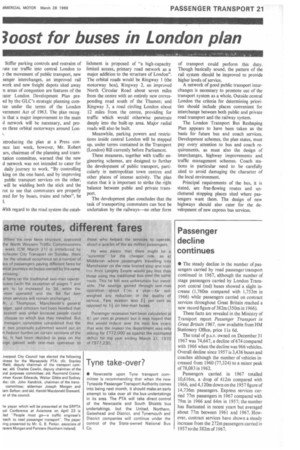loost for buses in London plan
Page 23

If you've noticed an error in this article please click here to report it so we can fix it.
Stiffer parking controls and restraint of rate car traffic into central London to the movement of public transport, new senger interchanges, an improved rail work and new freight depots sited away 11 areas of congestion are features of the ater London Development Plan preed by the GLC's strategic planning corntee under the terms of the London vernment Act of 1963. The plan recog3s that a major improvement to the main d network will be necessary, and proes three orbital motorways around Lon
Mroducing the plan at a Press con:nce last week, however, Mr. Robert ars, chairman of the planning and transtation committee, warned that the new d network was not intended to cater for daily journey to work. "By controlling king on the one hand, and by improving public transport services on the other, will be wielding both the stick and the rot to see that commuters are properly ued for by buses, trains and tubes", he lishment is proposed of "a high-capacity limited access, primary road network as a major addition to the structure of London". The orbital roads would be Ringway 1 (the motorway box), Ringway 2, an improved North Circular Road about seven miles from the centre with an entirely new corresponding road south of the Thames; and Ringway 3, a road circling London about 12 miles from the centre, providing for traffic which would otherwise penetrate deeply into the built-up area. Major radial roads will also be built.
Meanwhile, parking powers and restrictions inside central London will be stepped up, under terms contained in the Transport (London) Bill currently before Parliament.
These measures, together with traffic engineering schemes, are designed to further the development of public transport, particularly in metropolitan town centres and other places of intense activity. The plan states that it is important to strike the right balance between public and private trans The development plan concludes that the task of transporting commuters can best be undertaken by the railways—no other form of transport could perform this duty. Though basically sound, the pattern of the rail system should be improved to provide higher levels of service.
A network of good public transport interchanges is necessary to promote use of the transport system as a whole. Outside central London the criteria for determining priorities should include places convenient for interchange between both public and private road transport and the railway system.
The London Transport Bus Reshaping Plan appears to have been taken as the basis for future bus and coach services. Development schemes, the plan states, must pay every attention to bus and coach requirements, as must also the design of interchanges, highway improvements and traffic management schemes. Coach stations in particular need to be carefully sited to avoid damaging the character of the local environment.
Principal requirements of the bus, it is stated, are free-flowing routes and uncluttered stopping places sited where passengers want them. The design of new highways should also cater for the development of new express bus services.










































































































